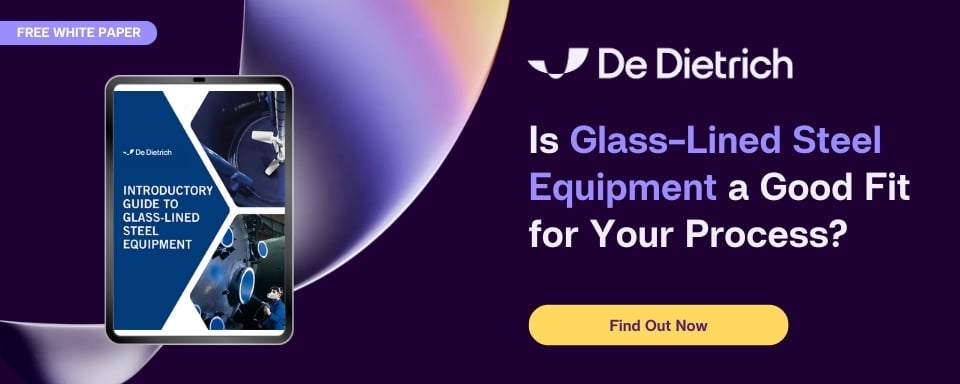Designing a Glass-Lined Vessel: How to Specify a Reactor [Part 1]

Editor’s Note: This post was originally published in January 2015 and has been updated for accuracy, clarity, and to reflect the latest information.
While price often plays a major role in purchasing decisions, it’s not always the top priority. For example, purchasing criteria such as quality, delivery time, customization options, and aftermarket services can carry more weight. This is particularly true for glass-lined reactors, which are essential components in many chemical and pharmaceutical processes and require a high degree of precision and engineering.
Today’s process engineers and project managers often begin their equipment research online. The internet offers a convenient, low-pressure way to gather information anytime, from virtually anywhere. However, when it comes to specifying and budgeting for a high-value, highly engineered system, there may come a point when discussing the requirements can be beneficial. Whether by phone or email, our team is available to help you obtain a reliable, tailored budgetary quote.
At De Dietrich, we also aim to make this process as smooth as possible via our website. To ensure the quote you receive is accurate, it's important to provide as much detail as possible in your RFQ. Glass-lined reactors are available in numerous sizes and configurations, and determining process parameters will help to provide a representative estimate.
This post outlines the key information we request in our Glass-Lined Reactor Specification Form. Whenever you are sourcing glass lined equipment, the following considerations will help you define the requirements necessary to move forward with a quote. (And don’t worry—if you're unsure about a field, simply note “don’t know” or leave it blank. That’s when our team steps in to help.)
1. Reactor Type and Size
Glass-lined reactors come in several types, each with features tailored to specific applications. Size is another critical factor—determined in part by your minimum and maximum batch volume, which helps define the optimal working volume. While every process is different, a general guideline is to use 70–80% of the vessel’s total capacity for effective batch processing.
Here’s a quick summary of De Dietrich’s standard reactor models and our unique designations:
- Laboratory Reactors – Available in 6.3 or 25 L sizes for research and development use.
- CTJ Reactors – 5 to 2,000 gallons; clamped-top design with a removable top head.
- GL Reactors – 300 to 10,000+ gallons; closed-welded design with no large main opening, offering higher pressure ratings.
- SA Reactors – 300 to 10,000 gallons; heavy-duty construction with a large top head opening for one-piece agitator installation.
- Storage Tanks – 300 to 16,000+ gallons; ideal for corrosion-resistant storage applications.
Selecting “Include OptiMix” on the form will specify a design that incorporates our patented baffle system, which improves mixing efficiency through three integrated wall-mounted baffles.
2. Vessel Lining
Three glass grades are available:
- 3009 Blue – Blue glass lining
- 3009 U White – White glass lining
- 3009HA – Offers features for harsh applications available in blue glass
- ConductiGlass® – Embedded with platinum fibers to dissipate static charges and prevent electrostatic damage.
3009 glass offered by De Dietrich offers excellent resistance for applications with highly corrosive processes. Being adapted to cGMP requirements allows this glass to be used where cleanliness and sterilization are crucial. It is a multipurpose material with a variety of uses because the formulation is impervious meaning there is no catalytic effect and no contamination. Lastly, its anti-adhesive properties make it appropriate for polymerization processes. DD 3009, whether in blue or white color, is one glass with optimum quality for all products all over the world.
3. Design Code
The American Society of Mechanical Engineers (ASME) provides a standard boiler and pressure vessel code (BPVC) to ensure vessels are built in accordance with the rules they’ve established for safety and service life. De Dietrich provides glass-lined vessels in accordance to ASME Section VIII.
4. Inspection Requirements
Careful inspections are performed by De Dietrich to ensure glass lined equipment meets regulatory requirements. In some cases, such as the pharmaceutical applications, additional GMP compliance can be conducted.
5. X-Ray Examination
X-ray inspection is used to examine weld integrity and detect foreign particles inside the vessel. This non-destructive testing method reveals issues that may not be visible through standard visual inspections.
6. Design Conditions
All De Dietrich reactors are manufactured with a standard pressure and temperature range that applies to the inner vessel, jacket, and half coil pipes in the case of HemiCoil jacketed reactors. The normal pressure and temperature ranges are:
- Pressure: –1 / +6 bar
- Temperature: –25°C to +200°C
Designs are available that exceed these typical design conditions, so if you require greater allowances it should be made clear in this section.
Ready for more information? Read our blog post where we continue our discussion with identifying vessel working conditions and talk more about other components that need to be recognized when specifying a reactor design to obtain a quote. Or click on this link to review our form and get yourself one step closer to receiving a hassle-free quote to meet your new equipment needs.
Whether you’re early in the planning phase or ready to move forward with a project, we’re here to help make your reactor sourcing process as efficient and informative as possible.
